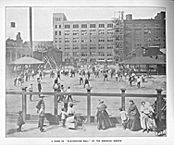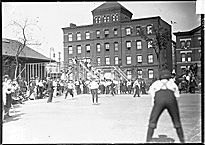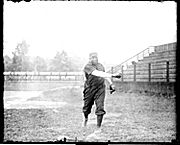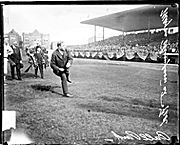| Entries |
| B |
|
Baseball
|

|
The earliest recorded game in the Chicago area was played in August 1851 between amateur teams from Joliet and Lockport. The Union Baseball Club was organized in Chicago in 1856; city newspapers first reported on its August 1858 game against the Excelsiors. Baseball experienced a rapid growth in popularity in Chicago after the Civil War. By 1867 there were 45 amateur teams competing in the city. By 1870 the newspapers of Chicago were reporting the results of games played between amateur teams, company teams, and youth teams.

|
Semiprofessional baseball in Chicago and surrounding suburban areas continued to grow from 1900 to 1910, both in overall quality of play and fan attendance at the city's dozen enclosed ballparks. During this period Chicago's legendary semipro teams—the Logan Squares, the Gunthers, and the West Ends—were all organized. Similar expansion also continued in the ranks of Chicago amateur baseball and in the industrial leagues. In the days before softball became a popular recreational sport, amateur baseball fulfilled that role in Chicago. The city's newspapers carried reports of games in a wide range of leagues sponsored by organizations such as churches, corporations, fraternal orders, banks, hardware dealers, and jewelers.
The Chicago City League returned to operation in 1909 with six teams, at least three of which were described as “professional” clubs, including the African American Leland Giants, one of many teams to emerge as a result of baseball's racial segregation. Chicago claimed a unique place in baseball history on the night of August 27, 1910, as the Logan Squares and Rogers Park played the sport's first successful night game under artificial lights at Comiskey Park.

|
In 1871, Northwestern University played its first baseball game against non-Northwestern competition. The University of Chicago won or shared four Big Ten Conference championships before it left the league in 1947. The Maroon baseball teams also took several exhibition tours to Japan, the first in 1910.
The first interscholastic baseball game in Chicago was played in October 1868 between two private prep schools, Chicago Academy and Beleke Academy. In 1890 seven public high schools organized the Cook County League amidst the rapidly spreading popularity of baseball among the city's secondary schools. The Chicago Public League came into existence in 1914; Crane High School won the league's first baseball championship.

|
By the final years of the twentieth century, minor league baseball had also come to Chicago. Going into the 2002 season, the metropolitan area was home to the Cook County Cheetahs (playing in Crestwood ), the Kane County Cougars (in Geneva ), the Schaumburg Flyers, and the Gary Railcats.
The Encyclopedia of Chicago © 2004 The Newberry Library. All Rights Reserved. Portions are copyrighted by other institutions and individuals. Additional information on copyright and permissions.